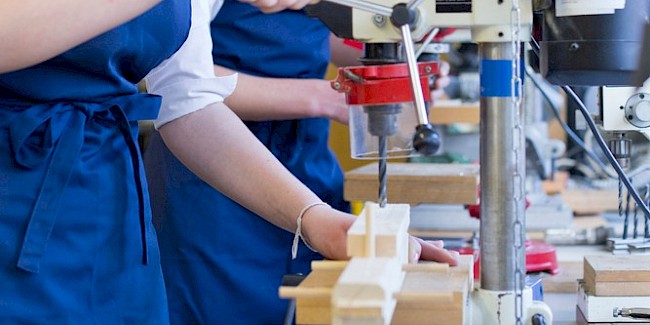Key Stage 5 IB Product Design
Curriculum Overview
Students at Key Stage 5 follow the IB Product Design course as part of the IB Diploma.
| | Term 1 | Term 2 | Term 3 | Term 4 | Term 5 | Term 6 |
|---|
| Year 12 | Innovation and Design (CORE 5)
Modelling (CORE 3) Innovation & Markets (AHL 9) | Human Factors & Ergonomics (CORE 1)
Modelling (CORE 3) User-Centred Design (AHL 7) | Modelling (CORE 3)
Final Production (CORE 4) Commercial Production (AHL 10) Innovation & Markets (AHL 9) Start ‘Individual Design Project’ | Final Production (CORE 4)
User-Centred Design (AHL 7) Innovation & Markets (AHL 9) | Resource Management & Sustainable Production (CORE 2)
Sustainability (AHL 8) | Resource Management & Sustainable Production (CORE 2)
Sustainability (AHL 8) |
| Year 13 | Group 4 Project | Resource Management & Sustainable Production (CORE 2)
Innovation & Markets (AHL 9) Commercial Production (AHL 10) | Classic Design (CORE 6)
Commercial Production (AHL 10) | | | |
Year 12
In Year 12, students will explore the CORE Theory for both Standard and Higher Level:
Core
- Human factors and ergonomics
- Resource management and sustainable production
- Modelling
- Final production
- Innovation and design
- Classic design
In addition, the Higher Level students will investigate the following elements:
Additional Higher Level (AHL)
- User-centred design (UCD)
- Sustainability
- Innovation and markets
- Commercial production
Both Standard and Higher Level students will begin their ‘Individual Design Projects’ during Term 3 of Year 12, which needs to be completed by Term 3 of Year 13.
Year 13
In Year 13, students continue to explore the CORE Theory for both Standard and Higher Level and any additional Higher Level Theory.
In Term 1 of Year 13, students will carry out a ‘Group 4 Project’: The emphasis throughout this project is group work. Working collaboratively in a team requires a certain amount of self-awareness and empathy with the other team members, as well as a high level of communication and motivation.
Assessment at IB
| Standard Level | Higher Level |
|---|
| External Assessment
Paper 1 – 1 Hour – 30% Multiple-choice questions on core and HL extension material. Paper 2 – 1.5 Hours – 30% Data based, short-answer, and extended-response questions on core material. | External Assessment
Paper 1 – 1 Hour – 20% Multiple-choice questions on core and HL extension material. Paper 2 – 1.5 Hours – 20% Data based, short-answer, and extended-response questions on core material. Paper 3 – 1.5 Hours – 20% Structured questions on HL extension material. |
| Internal Assessment
Individual Design Project – 40 Hours – 40% All standard and higher level students complete a design project as an internal assessment task. This design project allows them to demonstrate their investigative, analytical, design thinking, design development, prototyping, testing and evaluation skills and mirrors the design processes used across the various industries that integrate design practice. Internal assessment accounts for 40% of the final assessment. At SL, the design project requires students to identify a problem and develop a solution. It is assessed against four common criteria: - Analysis of a design opportunity
- Conceptual design
- Development of a detailed design
- Testing and evaluation
| Internal Assessment
Individual Design Project – 60 Hours – 40% All standard and higher level students complete a design project as an internal assessment task. This design project allows them to demonstrate their investigative, analytical, design thinking, design development, prototyping, testing and evaluation skills and mirrors the design processes used across the various industries that integrate design practice. Internal assessment accounts for 40% of the final assessment. At HL, the design project is extended to include aspects of innovation. The design project is assessed against two additional criteria: - Detailed development of a commercial product
- Making choices for commercial production
|
Further Reading/Resources
British Values:
British Values in Design and Technology
Democracy: Students democratically work together, in lower school KS3 classes, they demonstrate a great deal of group work and sharing of decision making.
Rule of law: We research and look at International and European Law, in the use of trademarks, patents, copyright……. We also study safety standards e.g. BSI (British Standards Institute) / Kitemark and EU Certification.
Individual Liberty: We encourages students to have a great deal of ‘Self Responsibility’, in the safe use of machines and tools. Students have to respect each other and their working environment.
Mutual respect: Design Technology students, are encouraged to have mutual respect of each others work and designs, through peer assessment and group analysis of work. This also links to the next statement, thinking about different beliefs and cultures, which is part of our GCSE syllabus.
Tolerance of those of different faiths and beliefs: Awareness of other cultural beliefs and styles can be incorporated into the design of products. Students are asked to research other cultures as part of their GCSE CORE theory, where students need to consider social, ethical and cultural issues, within designing and making.



